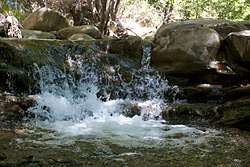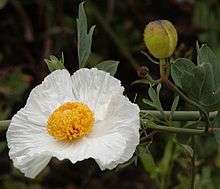Matilija Creek
Matilija Creek (/məˈtɪlɪhɑː/ mə-TIL-i-hah) is a major stream in Ventura County in the U.S. state of California. It joins with North Fork Matilija Creek to form the Ventura River.[4] Many tributaries feed the mostly free flowing, 17.3-mile (27.8 km) creek,[5] which is largely contained in the Matilija Wilderness. Matilija was one of the Chumash rancherias under the jurisdiction of Mission San Buenaventura. The meaning of the Chumash name is unknown.[6][7]
| Matilija Creek Arroyo Matilija [1] | |
|---|---|
Matilija Reservoir and Dam | |
| Location | |
| Country | United States of America |
| State | California |
| Physical characteristics | |
| Source | |
| • location | Santa Ynez Mountains, Santa Barbara County |
| • coordinates | 34°35′45″N 119°27′31″W |
| • elevation | 5,200 ft (1,600 m) |
| Mouth | Ventura River |
• location | Ventura County |
• coordinates | 34°29′06″N 119°18′01″W |
• elevation | 915 ft (279 m) |
| Length | 18 mi (29 km) |
| Basin size | 54.6 sq mi (141 km2) |
| Discharge | |
| • location | near Matilija Hot Springs[2] |
| • average | 43.3 cu ft/s (1.23 m3/s)[3] |
| • minimum | 0.03 cu ft/s (0.00085 m3/s) |
| • maximum | 8,780 cu ft/s (249 m3/s) |
| Basin features | |
| Tributaries | |
| • left | Middle Fork Matilija Creek, Upper North Fork Matilija Creek, North Fork Matilija Creek |
| • right | Old Man Canyon, Murietta Canyon |

Course
From its headwaters south of Sespe Creek in the Matilija Wilderness in Santa Barbara County, the creek flows east then south through a narrow V-shaped canyon into Ventura County. Below Matilija Falls it turns east and receives the Upper North Fork from the left, and almost immediately below that the West Fork (Murietta Canyon) from the right. The creek then flows east through a wider valley along the north side of the Santa Ynez Mountains before it empties into the mostly silted in Matilija Lake reservoir, formed by the 200-foot (61 m) high concrete arch Matilija Dam. Below the dam the creek flows southeast, through Matilija Hot Springs, and meets the North Fork Matilija Creek at the hamlet of Ojala, forming the Ventura River.
The smaller North Fork Matilija Creek[8] flows west and south from its headwaters near Rose Valley. The North Fork runs southwest, along Forest Route 6N31, and receives Cannon Creek from the right and Bear Creek from the left. It then cascades through the narrow Wheeler Gorge and through the community of Wheeler Springs. It flows briefly east and joins Matilija Creek shortly downstream. Highway 33 largely parallels the North Fork, from the top of Dry Lakes Ridge to the mouth.
Fed by some perennial springs, despite its location in arid terrain, the creek flows year round, and can flood severely following winter storms.[9]
Ecology

The name of the Matilija poppy (Romneya) is taken from the Matilija creek canyon.[6] The Matilija Dam was constructed in 1947 on lower Matilija Creek for the purpose of supplying water storage and flood control, blocking access of anadromous Steelhead trout (Oncorhynchus mykiss) to over ten miles of upstream spawning areas. Historically 5,000 steelhead trout used the upper Matilija basin. The Robles Diversion Dam on the Ventura River downstream posed a barrier to trout migration until a $6 million fish ladder was constructed in 2006.[10] Recent genetic analysis of the steelhead in Matilija Creek (both above and below Matilija Dam) has shown them to be of native and not hatchery stocks.[11]
River modifications
The creek has one dam on it, Matilija Dam, built in 1947 to provide flood control and water supply for agricultural and urban uses in Ventura County.[12] When completed, the dam was 190 feet (58 m) high and could impound more than 7,000 acre feet (0.0086 km3) of water. The reservoir has now almost completely filled with sediment, rendering it nearly useless. The dam was notched to reduce its height twice in the late 20th century, in order to allow some of the accumulated sediment to flow downstream. It is currently slated for removal.
See also
- Rindge Dam, which Malibu Creek filled with sediment like Matilija Dam
- Riparian zone restoration
References
- "Ventura County Centennial". Ventura County Historical Society Quarterly. 1972. Cite journal requires
|journal=(help) - "USGS Gage #11114495 on Matilija Creek near Reservoir, near Matilija Hot Springs, CA: Water-Data Report 2009" (PDF). National Water Information System. U.S. Geological Survey. 2002-present. Retrieved 2011-01-01. Check date values in:
|date=(help) - "USGS Gage #11114495 on Matilija Creek near Reservoir, near Matilija Hot Springs, CA: Water-Data Report 2009" (PDF). National Water Information System. U.S. Geological Survey. 2002-present. Retrieved 2011-01-01. Check date values in:
|date=(help) - U.S. Geological Survey Geographic Names Information System: Matilija Creek
- U.S. Geological Survey. National Hydrography Dataset high-resolution flowline data. The National Map Archived 2012-04-05 at WebCite, accessed March 16, 2011
- Erwin G. Gudde, William Bright (2004). California Place Names: The Origin and Etymology of Current Geographical Names. University of California Press. p. 231. ISBN 978-0-520-24217-3. Retrieved 2011-01-29.
- Durham, David L. (1998). California's Geographic Names: A Gazetteer of Historic and Modern Names of the State. Quill Driver Books. ISBN 978-1-884995-14-9.
- U.S. Geological Survey Geographic Names Information System: North Fork Matilija Creek
- Lawrence, Carol (June 23, 2016). "Ojai residents use public agencies to halt center at Matilija hot springs for now". Ventura County Star. Retrieved 5 September 2016.
- "Efforts to Revive Southern California's Steelhead Fish Population and Recreational Fishing Industry". NOAA Fisheries. Retrieved 2011-01-29.
- Anthony J. Clemento, Eric C. Anderson, David Boughton, Derek Girman, John Carlos Garza (2009). "Population genetic structure and ancestry of Oncorhynchus mykiss populations above and below dams in south-central California". Conservation Genetics. 10: 1321–1336. doi:10.1007/s10592-008-9712-0.CS1 maint: uses authors parameter (link)
- Miller, Joanna M. (March 20, 1994). "A Few Deadly Floods Stand Out in County". Los Angeles Times. Retrieved 19 March 2017.